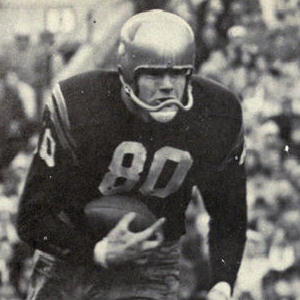

Notre Dame
1959 Monty Stickles
(Authentic Reproduction)
.jpg) |
 |
The well known golden
helmets of Notre Dame, newly painted before each game with paint that
reportedly contains flecks of real gold, has been a symbol of football
excellence since the days of Knute Rockne. These were changed in 1959 with
the addition of a green shamrock decal on each side of the gleaming gold
shell under the leadership of newly appointed head coach Joe Kuharich. The
hiring of Kuharich, a star at South Bend High School and as a tough-as-nails
155 pound guard and linebacker for the Fighting Irish, was supposed to cure
a number of football related ills. He had played professionally for the
Cardinals before entering the military and then worked his way up through
the coaching ranks. Named the NFL Coach Of The Year in 1955 as the Redskins
head man, he came to Notre Dame at a time of turmoil. Under the legendary
Frank Leahy, Notre Dame had won four National Championships, compiled an
87-11-9 record, and had six undefeated seasons. He left after the ’53
campaign, supposedly for health reasons but there was acrimony with the
administration that re-emphasized the academic mission of the school,
reduced scholarships, forced compliance with the usual admissions standards,
and essentially reigned in what had become a somewhat autonomous program
within the university.
.jpg) |
.jpg) |
Former Irish halfback Terry
Brennan became Leahy’s successor, a twenty-five year old who perhaps did not
realize the full difficulties of his situation. The roof fell in when the
1956 squad went 2-8 despite the presence of Heisman Trophy winner Paul
Hornung. The 7-3 mark of 1957 made the Irish “The Comeback Team Of The Year”
but after a 6-4 ’58 season, Brennan was relieved of his post, signaling
optimism that a new regime under Kuharich might reverse their football
fortunes. Brennan’s dismissal also brought a raft of criticism as Notre Dame
was deemed to be a “football factory” interested only in repairing its
athletic reputation. One of the key players in Kuharich’s inaugural season
would be senior end Montford Anthony Stickles of Poughkeepsie, N.Y. The
6’4”, 220 pound Stickles had been the first basketball player in the history
of Dutchess County to score 1000 points and earned twelve high school
letters. Kicking the winning field goal in a huge upset over Army in his
1957 sophomore season was but a prelude to a collegiate career of rough and
tumble play from both the end and linebacker positions. Kuharich’s first
season was a 5-5 morass of inconsistency but Stickles was a rock, always
terrific on both sides of the ball and with his kicking prowess. A Consensus
All American, he left behind a reputation of a true tough guy who was also
intent on securing a first-grade education, making him extremely popular
with Notre Dame’s many fans. He was rather easy to find on the field during
his senior season with his broad back emblazoned with number 80 streaking to
the opposing ball carrier or rushing with the football tucked under his arm.
His distinctive arched single bar mask made him more of a standout. As the
first round draft choice of the Forty Niners, Stickles earned his nickname
“Iron Jaw” as he admittedly played dirty and relished both dishing out and
receiving the ultimate level of pain on the field. Most fans would have been
shocked to hear his daughter’s description of the tight end who loved to go
toe-to-toe with linebackers during and after plays, and earned a reputation
for “playing all out” both on and off the field. "As a dad, he was great,''
said daughter Jessica Stickles Mattos. "He was a devoted father. He really
was an eclectic person. He collected art, he was a gourmet chef, he loved
jazz music.'' Stickles played well for the ‘Niners through the 1967 season
and completed his career in ’68 with the Saints before having a
distinguished career in sports casting and doing extremely well with real
estate investments.
.jpg) |
Kuharich made his mark at Notre Dame with the addition of the green shamrock to the gold helmet. The Irish opened the ’59 season with the standard all gold shell, facing off against North Carolina and Purdue in their first two games. When they took the field against Cal on October 10th, they unveiled the green shamrock design. However, the decal was placed upon each side of the helmet from a perspective that made it appear as if an airplane propeller was facing the observer, a most unique design! Some thought that the decal was placed upside down but it was merely an attempt by the Kuharich staff to help jolt the program into a new era. The same design was utilized for the practice period of 1960 and then replaced by the more familiar clover leaf as shown below on Daryl Lamonica's game helmet.
|
|
.jpg) |
Unfortunately, Kuharich’s second season was a
duplicate of Brennan’s 1956, and the 2-8 record was a result of eight consecutive losses that were bracketed by victories on the opening and closing days of the 1960 season. Two more 5-5 seasons resulted in Kuharich’s resignation and he returned to the NFL. Long time assistant Hugh Devore took over for the 1963 season, paving the way for Ara Parseghian’s arrival in 1964 and the ascension of Notre Dame to the very top of college football’s elite. To this day, the unique green shamrock designs remain a source of conversation for all Notre Dame and football helmet fans.
.jpg) |
.jpg) |